Analysis of Leadership and Management Roles at Ilford-on-Sea
VerifiedAdded on 2020/06/05
|13
|4167
|43
Report
AI Summary
This report provides a comprehensive analysis of leadership and management practices within the context of Ilford-on-Sea, a construction business. It begins by comparing the distinct roles and characteristics of leaders and managers, examining their responsibilities in team building, motivation, and maintaining relationships. The report then delves into the practical application of these roles in various situations, particularly under pressure and in managing multiple projects. Furthermore, it explores different leadership theories, including situational, system, and contingency leadership, evaluating their strengths and weaknesses. The core of the report centers on key approaches to operations management, such as Just-in-Time and Total Quality Management, and the crucial roles that leaders and managers play in improving operational efficiency. Finally, the report assesses the impact of both internal and external factors on the business environment, including decision-making processes, and concludes with a critical evaluation of the application of operations management principles. The report highlights the importance of effective leadership and management in achieving business objectives and adapting to environmental challenges.
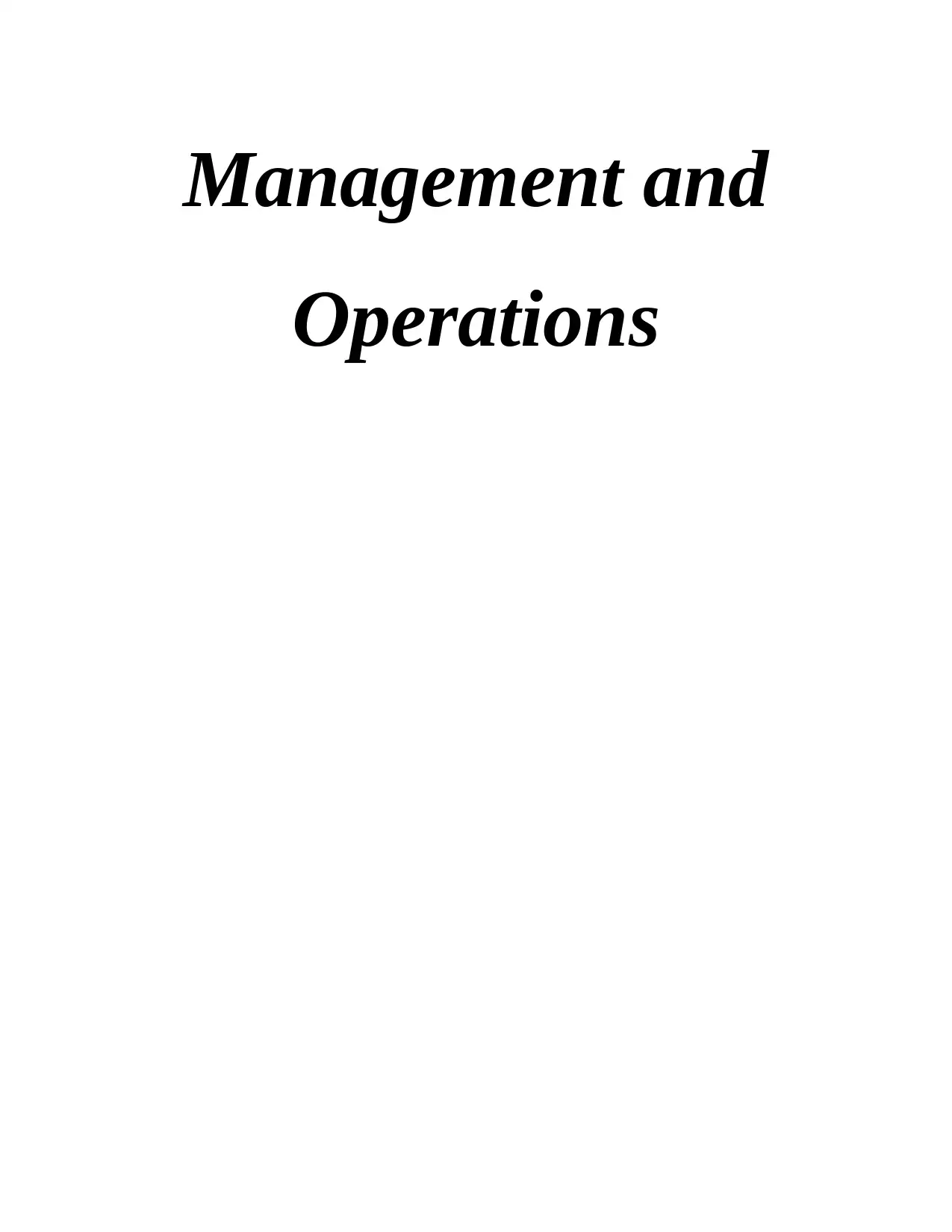
Management and
Operations
Operations
Paraphrase This Document
Need a fresh take? Get an instant paraphrase of this document with our AI Paraphraser
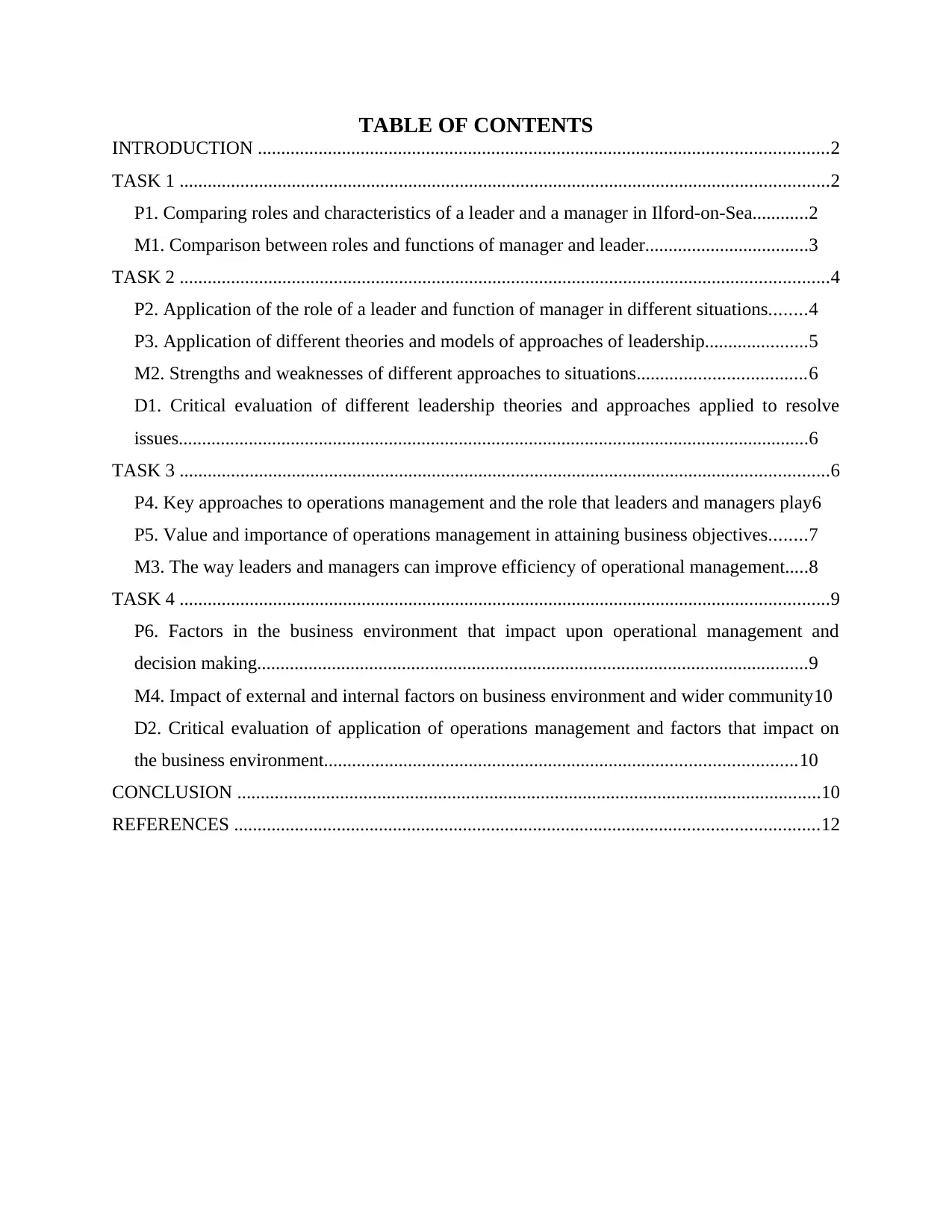
TABLE OF CONTENTS
INTRODUCTION ..........................................................................................................................2
TASK 1 ...........................................................................................................................................2
P1. Comparing roles and characteristics of a leader and a manager in Ilford-on-Sea............2
M1. Comparison between roles and functions of manager and leader...................................3
TASK 2 ...........................................................................................................................................4
P2. Application of the role of a leader and function of manager in different situations........4
P3. Application of different theories and models of approaches of leadership......................5
M2. Strengths and weaknesses of different approaches to situations....................................6
D1. Critical evaluation of different leadership theories and approaches applied to resolve
issues.......................................................................................................................................6
TASK 3 ...........................................................................................................................................6
P4. Key approaches to operations management and the role that leaders and managers play6
P5. Value and importance of operations management in attaining business objectives........7
M3. The way leaders and managers can improve efficiency of operational management.....8
TASK 4 ...........................................................................................................................................9
P6. Factors in the business environment that impact upon operational management and
decision making......................................................................................................................9
M4. Impact of external and internal factors on business environment and wider community10
D2. Critical evaluation of application of operations management and factors that impact on
the business environment.....................................................................................................10
CONCLUSION .............................................................................................................................10
REFERENCES .............................................................................................................................12
INTRODUCTION ..........................................................................................................................2
TASK 1 ...........................................................................................................................................2
P1. Comparing roles and characteristics of a leader and a manager in Ilford-on-Sea............2
M1. Comparison between roles and functions of manager and leader...................................3
TASK 2 ...........................................................................................................................................4
P2. Application of the role of a leader and function of manager in different situations........4
P3. Application of different theories and models of approaches of leadership......................5
M2. Strengths and weaknesses of different approaches to situations....................................6
D1. Critical evaluation of different leadership theories and approaches applied to resolve
issues.......................................................................................................................................6
TASK 3 ...........................................................................................................................................6
P4. Key approaches to operations management and the role that leaders and managers play6
P5. Value and importance of operations management in attaining business objectives........7
M3. The way leaders and managers can improve efficiency of operational management.....8
TASK 4 ...........................................................................................................................................9
P6. Factors in the business environment that impact upon operational management and
decision making......................................................................................................................9
M4. Impact of external and internal factors on business environment and wider community10
D2. Critical evaluation of application of operations management and factors that impact on
the business environment.....................................................................................................10
CONCLUSION .............................................................................................................................10
REFERENCES .............................................................................................................................12
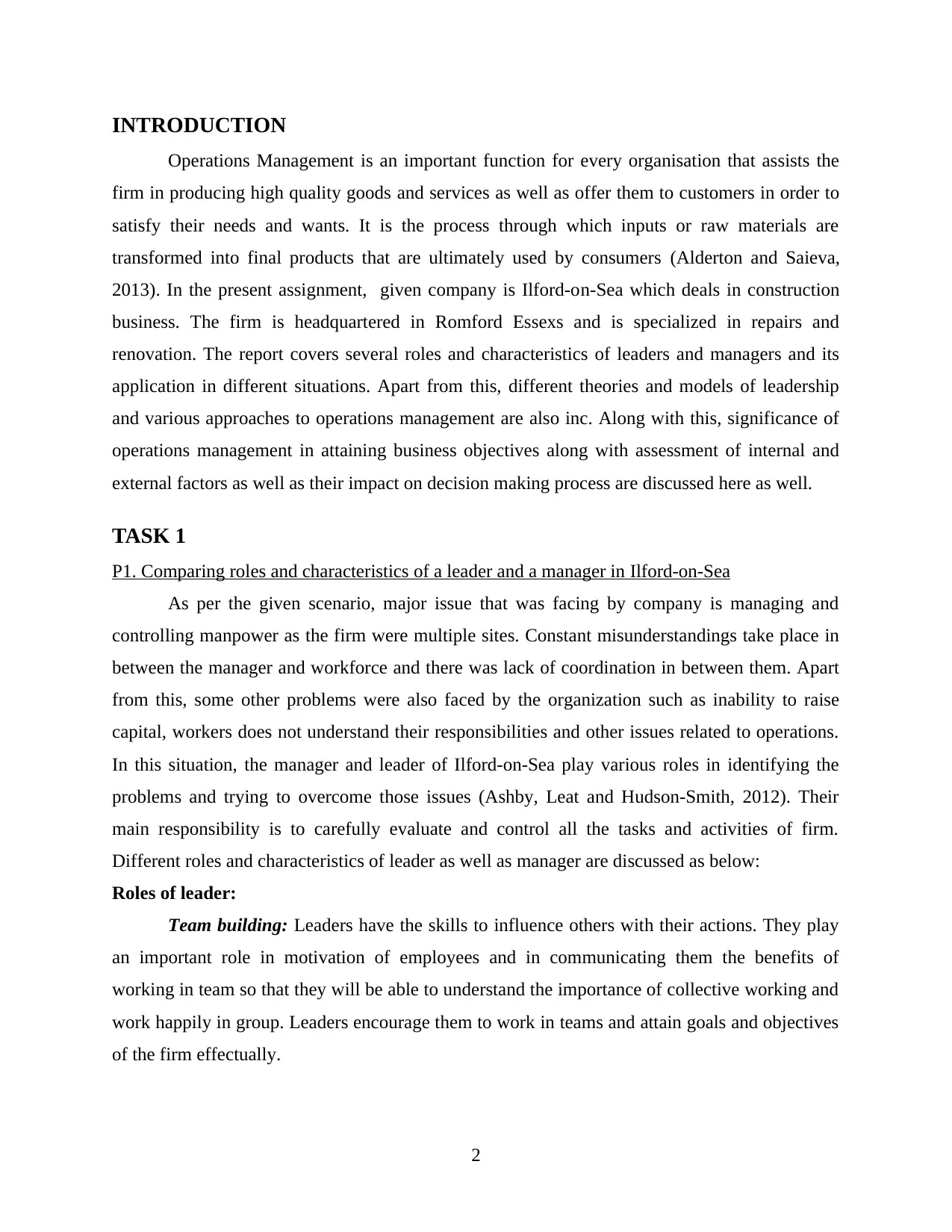
INTRODUCTION
Operations Management is an important function for every organisation that assists the
firm in producing high quality goods and services as well as offer them to customers in order to
satisfy their needs and wants. It is the process through which inputs or raw materials are
transformed into final products that are ultimately used by consumers (Alderton and Saieva,
2013). In the present assignment, given company is Ilford-on-Sea which deals in construction
business. The firm is headquartered in Romford Essexs and is specialized in repairs and
renovation. The report covers several roles and characteristics of leaders and managers and its
application in different situations. Apart from this, different theories and models of leadership
and various approaches to operations management are also inc. Along with this, significance of
operations management in attaining business objectives along with assessment of internal and
external factors as well as their impact on decision making process are discussed here as well.
TASK 1
P1. Comparing roles and characteristics of a leader and a manager in Ilford-on-Sea
As per the given scenario, major issue that was facing by company is managing and
controlling manpower as the firm were multiple sites. Constant misunderstandings take place in
between the manager and workforce and there was lack of coordination in between them. Apart
from this, some other problems were also faced by the organization such as inability to raise
capital, workers does not understand their responsibilities and other issues related to operations.
In this situation, the manager and leader of Ilford-on-Sea play various roles in identifying the
problems and trying to overcome those issues (Ashby, Leat and Hudson-Smith, 2012). Their
main responsibility is to carefully evaluate and control all the tasks and activities of firm.
Different roles and characteristics of leader as well as manager are discussed as below:
Roles of leader:
Team building: Leaders have the skills to influence others with their actions. They play
an important role in motivation of employees and in communicating them the benefits of
working in team so that they will be able to understand the importance of collective working and
work happily in group. Leaders encourage them to work in teams and attain goals and objectives
of the firm effectually.
2
Operations Management is an important function for every organisation that assists the
firm in producing high quality goods and services as well as offer them to customers in order to
satisfy their needs and wants. It is the process through which inputs or raw materials are
transformed into final products that are ultimately used by consumers (Alderton and Saieva,
2013). In the present assignment, given company is Ilford-on-Sea which deals in construction
business. The firm is headquartered in Romford Essexs and is specialized in repairs and
renovation. The report covers several roles and characteristics of leaders and managers and its
application in different situations. Apart from this, different theories and models of leadership
and various approaches to operations management are also inc. Along with this, significance of
operations management in attaining business objectives along with assessment of internal and
external factors as well as their impact on decision making process are discussed here as well.
TASK 1
P1. Comparing roles and characteristics of a leader and a manager in Ilford-on-Sea
As per the given scenario, major issue that was facing by company is managing and
controlling manpower as the firm were multiple sites. Constant misunderstandings take place in
between the manager and workforce and there was lack of coordination in between them. Apart
from this, some other problems were also faced by the organization such as inability to raise
capital, workers does not understand their responsibilities and other issues related to operations.
In this situation, the manager and leader of Ilford-on-Sea play various roles in identifying the
problems and trying to overcome those issues (Ashby, Leat and Hudson-Smith, 2012). Their
main responsibility is to carefully evaluate and control all the tasks and activities of firm.
Different roles and characteristics of leader as well as manager are discussed as below:
Roles of leader:
Team building: Leaders have the skills to influence others with their actions. They play
an important role in motivation of employees and in communicating them the benefits of
working in team so that they will be able to understand the importance of collective working and
work happily in group. Leaders encourage them to work in teams and attain goals and objectives
of the firm effectually.
2
⊘ This is a preview!⊘
Do you want full access?
Subscribe today to unlock all pages.

Trusted by 1+ million students worldwide
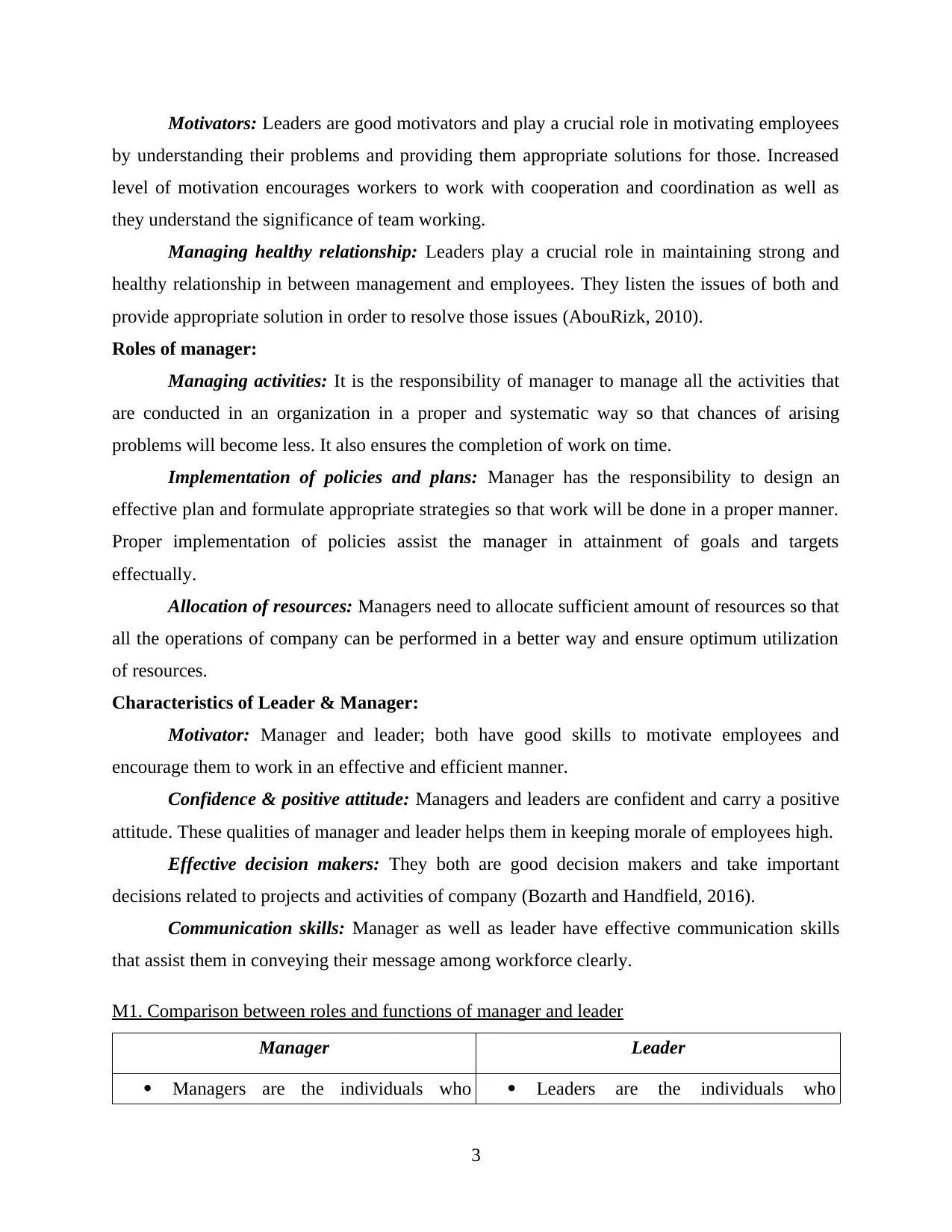
Motivators: Leaders are good motivators and play a crucial role in motivating employees
by understanding their problems and providing them appropriate solutions for those. Increased
level of motivation encourages workers to work with cooperation and coordination as well as
they understand the significance of team working.
Managing healthy relationship: Leaders play a crucial role in maintaining strong and
healthy relationship in between management and employees. They listen the issues of both and
provide appropriate solution in order to resolve those issues (AbouRizk, 2010).
Roles of manager:
Managing activities: It is the responsibility of manager to manage all the activities that
are conducted in an organization in a proper and systematic way so that chances of arising
problems will become less. It also ensures the completion of work on time.
Implementation of policies and plans: Manager has the responsibility to design an
effective plan and formulate appropriate strategies so that work will be done in a proper manner.
Proper implementation of policies assist the manager in attainment of goals and targets
effectually.
Allocation of resources: Managers need to allocate sufficient amount of resources so that
all the operations of company can be performed in a better way and ensure optimum utilization
of resources.
Characteristics of Leader & Manager:
Motivator: Manager and leader; both have good skills to motivate employees and
encourage them to work in an effective and efficient manner.
Confidence & positive attitude: Managers and leaders are confident and carry a positive
attitude. These qualities of manager and leader helps them in keeping morale of employees high.
Effective decision makers: They both are good decision makers and take important
decisions related to projects and activities of company (Bozarth and Handfield, 2016).
Communication skills: Manager as well as leader have effective communication skills
that assist them in conveying their message among workforce clearly.
M1. Comparison between roles and functions of manager and leader
Manager Leader
Managers are the individuals who Leaders are the individuals who
3
by understanding their problems and providing them appropriate solutions for those. Increased
level of motivation encourages workers to work with cooperation and coordination as well as
they understand the significance of team working.
Managing healthy relationship: Leaders play a crucial role in maintaining strong and
healthy relationship in between management and employees. They listen the issues of both and
provide appropriate solution in order to resolve those issues (AbouRizk, 2010).
Roles of manager:
Managing activities: It is the responsibility of manager to manage all the activities that
are conducted in an organization in a proper and systematic way so that chances of arising
problems will become less. It also ensures the completion of work on time.
Implementation of policies and plans: Manager has the responsibility to design an
effective plan and formulate appropriate strategies so that work will be done in a proper manner.
Proper implementation of policies assist the manager in attainment of goals and targets
effectually.
Allocation of resources: Managers need to allocate sufficient amount of resources so that
all the operations of company can be performed in a better way and ensure optimum utilization
of resources.
Characteristics of Leader & Manager:
Motivator: Manager and leader; both have good skills to motivate employees and
encourage them to work in an effective and efficient manner.
Confidence & positive attitude: Managers and leaders are confident and carry a positive
attitude. These qualities of manager and leader helps them in keeping morale of employees high.
Effective decision makers: They both are good decision makers and take important
decisions related to projects and activities of company (Bozarth and Handfield, 2016).
Communication skills: Manager as well as leader have effective communication skills
that assist them in conveying their message among workforce clearly.
M1. Comparison between roles and functions of manager and leader
Manager Leader
Managers are the individuals who Leaders are the individuals who
3
Paraphrase This Document
Need a fresh take? Get an instant paraphrase of this document with our AI Paraphraser
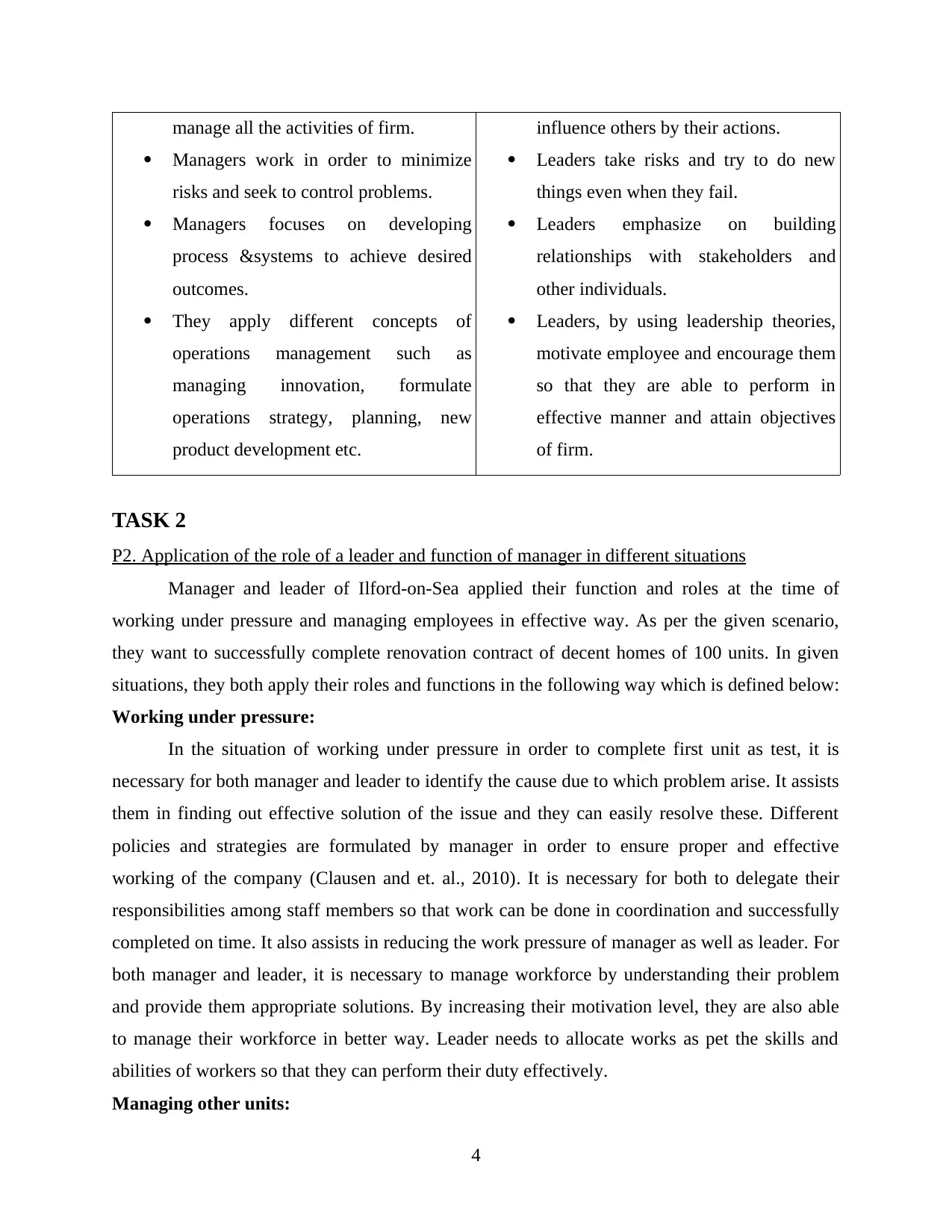
manage all the activities of firm.
Managers work in order to minimize
risks and seek to control problems.
Managers focuses on developing
process &systems to achieve desired
outcomes.
They apply different concepts of
operations management such as
managing innovation, formulate
operations strategy, planning, new
product development etc.
influence others by their actions.
Leaders take risks and try to do new
things even when they fail.
Leaders emphasize on building
relationships with stakeholders and
other individuals.
Leaders, by using leadership theories,
motivate employee and encourage them
so that they are able to perform in
effective manner and attain objectives
of firm.
TASK 2
P2. Application of the role of a leader and function of manager in different situations
Manager and leader of Ilford-on-Sea applied their function and roles at the time of
working under pressure and managing employees in effective way. As per the given scenario,
they want to successfully complete renovation contract of decent homes of 100 units. In given
situations, they both apply their roles and functions in the following way which is defined below:
Working under pressure:
In the situation of working under pressure in order to complete first unit as test, it is
necessary for both manager and leader to identify the cause due to which problem arise. It assists
them in finding out effective solution of the issue and they can easily resolve these. Different
policies and strategies are formulated by manager in order to ensure proper and effective
working of the company (Clausen and et. al., 2010). It is necessary for both to delegate their
responsibilities among staff members so that work can be done in coordination and successfully
completed on time. It also assists in reducing the work pressure of manager as well as leader. For
both manager and leader, it is necessary to manage workforce by understanding their problem
and provide them appropriate solutions. By increasing their motivation level, they are also able
to manage their workforce in better way. Leader needs to allocate works as pet the skills and
abilities of workers so that they can perform their duty effectively.
Managing other units:
4
Managers work in order to minimize
risks and seek to control problems.
Managers focuses on developing
process &systems to achieve desired
outcomes.
They apply different concepts of
operations management such as
managing innovation, formulate
operations strategy, planning, new
product development etc.
influence others by their actions.
Leaders take risks and try to do new
things even when they fail.
Leaders emphasize on building
relationships with stakeholders and
other individuals.
Leaders, by using leadership theories,
motivate employee and encourage them
so that they are able to perform in
effective manner and attain objectives
of firm.
TASK 2
P2. Application of the role of a leader and function of manager in different situations
Manager and leader of Ilford-on-Sea applied their function and roles at the time of
working under pressure and managing employees in effective way. As per the given scenario,
they want to successfully complete renovation contract of decent homes of 100 units. In given
situations, they both apply their roles and functions in the following way which is defined below:
Working under pressure:
In the situation of working under pressure in order to complete first unit as test, it is
necessary for both manager and leader to identify the cause due to which problem arise. It assists
them in finding out effective solution of the issue and they can easily resolve these. Different
policies and strategies are formulated by manager in order to ensure proper and effective
working of the company (Clausen and et. al., 2010). It is necessary for both to delegate their
responsibilities among staff members so that work can be done in coordination and successfully
completed on time. It also assists in reducing the work pressure of manager as well as leader. For
both manager and leader, it is necessary to manage workforce by understanding their problem
and provide them appropriate solutions. By increasing their motivation level, they are also able
to manage their workforce in better way. Leader needs to allocate works as pet the skills and
abilities of workers so that they can perform their duty effectively.
Managing other units:
4
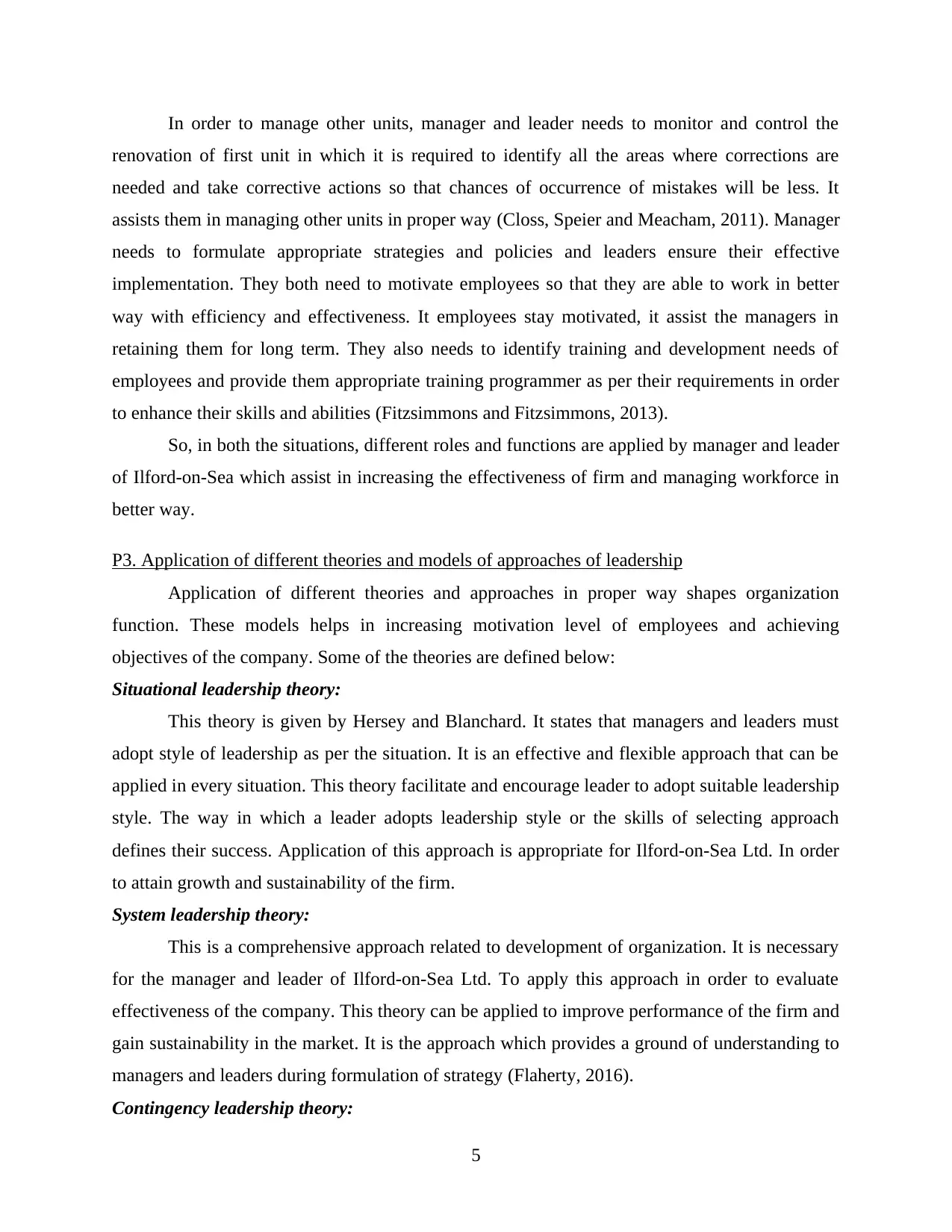
In order to manage other units, manager and leader needs to monitor and control the
renovation of first unit in which it is required to identify all the areas where corrections are
needed and take corrective actions so that chances of occurrence of mistakes will be less. It
assists them in managing other units in proper way (Closs, Speier and Meacham, 2011). Manager
needs to formulate appropriate strategies and policies and leaders ensure their effective
implementation. They both need to motivate employees so that they are able to work in better
way with efficiency and effectiveness. It employees stay motivated, it assist the managers in
retaining them for long term. They also needs to identify training and development needs of
employees and provide them appropriate training programmer as per their requirements in order
to enhance their skills and abilities (Fitzsimmons and Fitzsimmons, 2013).
So, in both the situations, different roles and functions are applied by manager and leader
of Ilford-on-Sea which assist in increasing the effectiveness of firm and managing workforce in
better way.
P3. Application of different theories and models of approaches of leadership
Application of different theories and approaches in proper way shapes organization
function. These models helps in increasing motivation level of employees and achieving
objectives of the company. Some of the theories are defined below:
Situational leadership theory:
This theory is given by Hersey and Blanchard. It states that managers and leaders must
adopt style of leadership as per the situation. It is an effective and flexible approach that can be
applied in every situation. This theory facilitate and encourage leader to adopt suitable leadership
style. The way in which a leader adopts leadership style or the skills of selecting approach
defines their success. Application of this approach is appropriate for Ilford-on-Sea Ltd. In order
to attain growth and sustainability of the firm.
System leadership theory:
This is a comprehensive approach related to development of organization. It is necessary
for the manager and leader of Ilford-on-Sea Ltd. To apply this approach in order to evaluate
effectiveness of the company. This theory can be applied to improve performance of the firm and
gain sustainability in the market. It is the approach which provides a ground of understanding to
managers and leaders during formulation of strategy (Flaherty, 2016).
Contingency leadership theory:
5
renovation of first unit in which it is required to identify all the areas where corrections are
needed and take corrective actions so that chances of occurrence of mistakes will be less. It
assists them in managing other units in proper way (Closs, Speier and Meacham, 2011). Manager
needs to formulate appropriate strategies and policies and leaders ensure their effective
implementation. They both need to motivate employees so that they are able to work in better
way with efficiency and effectiveness. It employees stay motivated, it assist the managers in
retaining them for long term. They also needs to identify training and development needs of
employees and provide them appropriate training programmer as per their requirements in order
to enhance their skills and abilities (Fitzsimmons and Fitzsimmons, 2013).
So, in both the situations, different roles and functions are applied by manager and leader
of Ilford-on-Sea which assist in increasing the effectiveness of firm and managing workforce in
better way.
P3. Application of different theories and models of approaches of leadership
Application of different theories and approaches in proper way shapes organization
function. These models helps in increasing motivation level of employees and achieving
objectives of the company. Some of the theories are defined below:
Situational leadership theory:
This theory is given by Hersey and Blanchard. It states that managers and leaders must
adopt style of leadership as per the situation. It is an effective and flexible approach that can be
applied in every situation. This theory facilitate and encourage leader to adopt suitable leadership
style. The way in which a leader adopts leadership style or the skills of selecting approach
defines their success. Application of this approach is appropriate for Ilford-on-Sea Ltd. In order
to attain growth and sustainability of the firm.
System leadership theory:
This is a comprehensive approach related to development of organization. It is necessary
for the manager and leader of Ilford-on-Sea Ltd. To apply this approach in order to evaluate
effectiveness of the company. This theory can be applied to improve performance of the firm and
gain sustainability in the market. It is the approach which provides a ground of understanding to
managers and leaders during formulation of strategy (Flaherty, 2016).
Contingency leadership theory:
5
⊘ This is a preview!⊘
Do you want full access?
Subscribe today to unlock all pages.

Trusted by 1+ million students worldwide
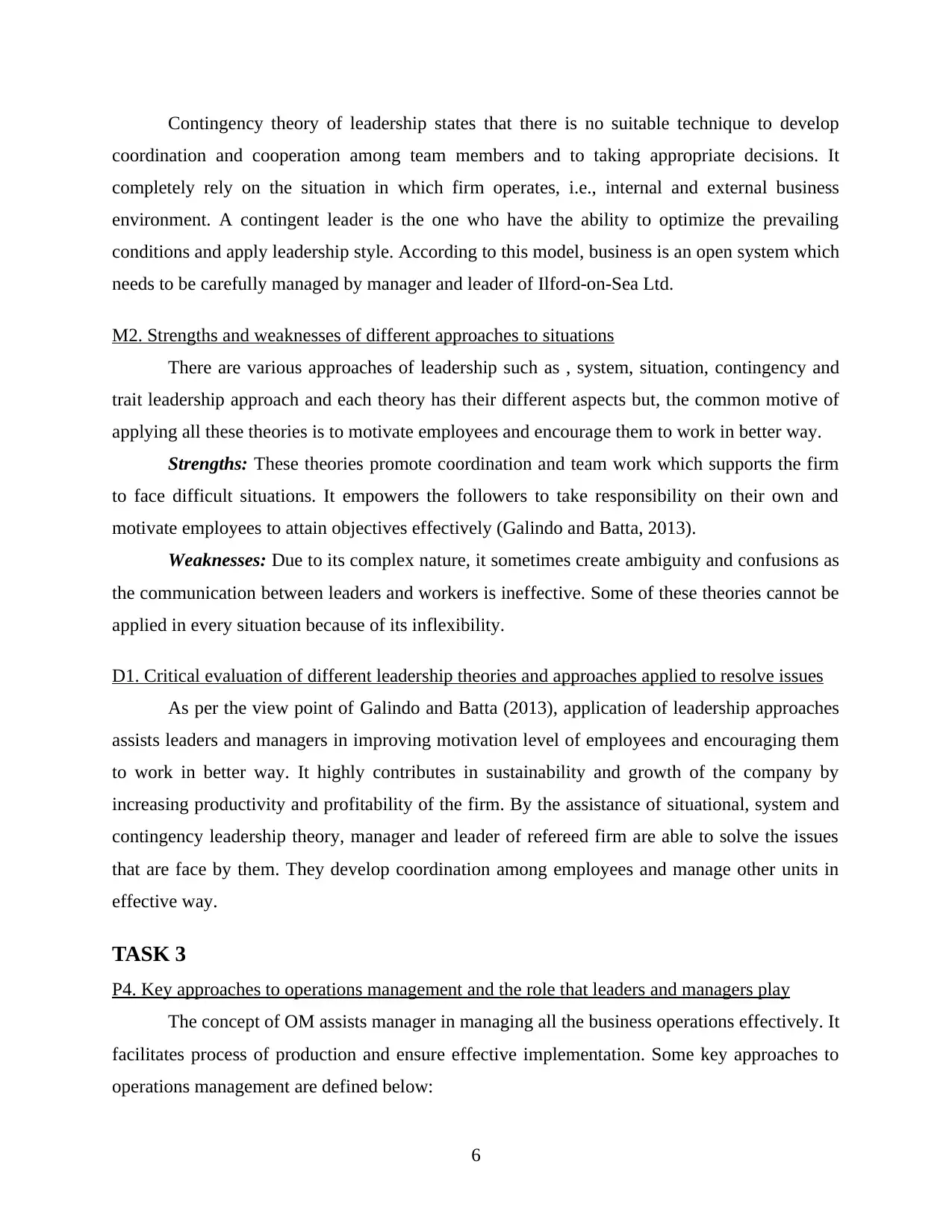
Contingency theory of leadership states that there is no suitable technique to develop
coordination and cooperation among team members and to taking appropriate decisions. It
completely rely on the situation in which firm operates, i.e., internal and external business
environment. A contingent leader is the one who have the ability to optimize the prevailing
conditions and apply leadership style. According to this model, business is an open system which
needs to be carefully managed by manager and leader of Ilford-on-Sea Ltd.
M2. Strengths and weaknesses of different approaches to situations
There are various approaches of leadership such as , system, situation, contingency and
trait leadership approach and each theory has their different aspects but, the common motive of
applying all these theories is to motivate employees and encourage them to work in better way.
Strengths: These theories promote coordination and team work which supports the firm
to face difficult situations. It empowers the followers to take responsibility on their own and
motivate employees to attain objectives effectively (Galindo and Batta, 2013).
Weaknesses: Due to its complex nature, it sometimes create ambiguity and confusions as
the communication between leaders and workers is ineffective. Some of these theories cannot be
applied in every situation because of its inflexibility.
D1. Critical evaluation of different leadership theories and approaches applied to resolve issues
As per the view point of Galindo and Batta (2013), application of leadership approaches
assists leaders and managers in improving motivation level of employees and encouraging them
to work in better way. It highly contributes in sustainability and growth of the company by
increasing productivity and profitability of the firm. By the assistance of situational, system and
contingency leadership theory, manager and leader of refereed firm are able to solve the issues
that are face by them. They develop coordination among employees and manage other units in
effective way.
TASK 3
P4. Key approaches to operations management and the role that leaders and managers play
The concept of OM assists manager in managing all the business operations effectively. It
facilitates process of production and ensure effective implementation. Some key approaches to
operations management are defined below:
6
coordination and cooperation among team members and to taking appropriate decisions. It
completely rely on the situation in which firm operates, i.e., internal and external business
environment. A contingent leader is the one who have the ability to optimize the prevailing
conditions and apply leadership style. According to this model, business is an open system which
needs to be carefully managed by manager and leader of Ilford-on-Sea Ltd.
M2. Strengths and weaknesses of different approaches to situations
There are various approaches of leadership such as , system, situation, contingency and
trait leadership approach and each theory has their different aspects but, the common motive of
applying all these theories is to motivate employees and encourage them to work in better way.
Strengths: These theories promote coordination and team work which supports the firm
to face difficult situations. It empowers the followers to take responsibility on their own and
motivate employees to attain objectives effectively (Galindo and Batta, 2013).
Weaknesses: Due to its complex nature, it sometimes create ambiguity and confusions as
the communication between leaders and workers is ineffective. Some of these theories cannot be
applied in every situation because of its inflexibility.
D1. Critical evaluation of different leadership theories and approaches applied to resolve issues
As per the view point of Galindo and Batta (2013), application of leadership approaches
assists leaders and managers in improving motivation level of employees and encouraging them
to work in better way. It highly contributes in sustainability and growth of the company by
increasing productivity and profitability of the firm. By the assistance of situational, system and
contingency leadership theory, manager and leader of refereed firm are able to solve the issues
that are face by them. They develop coordination among employees and manage other units in
effective way.
TASK 3
P4. Key approaches to operations management and the role that leaders and managers play
The concept of OM assists manager in managing all the business operations effectively. It
facilitates process of production and ensure effective implementation. Some key approaches to
operations management are defined below:
6
Paraphrase This Document
Need a fresh take? Get an instant paraphrase of this document with our AI Paraphraser
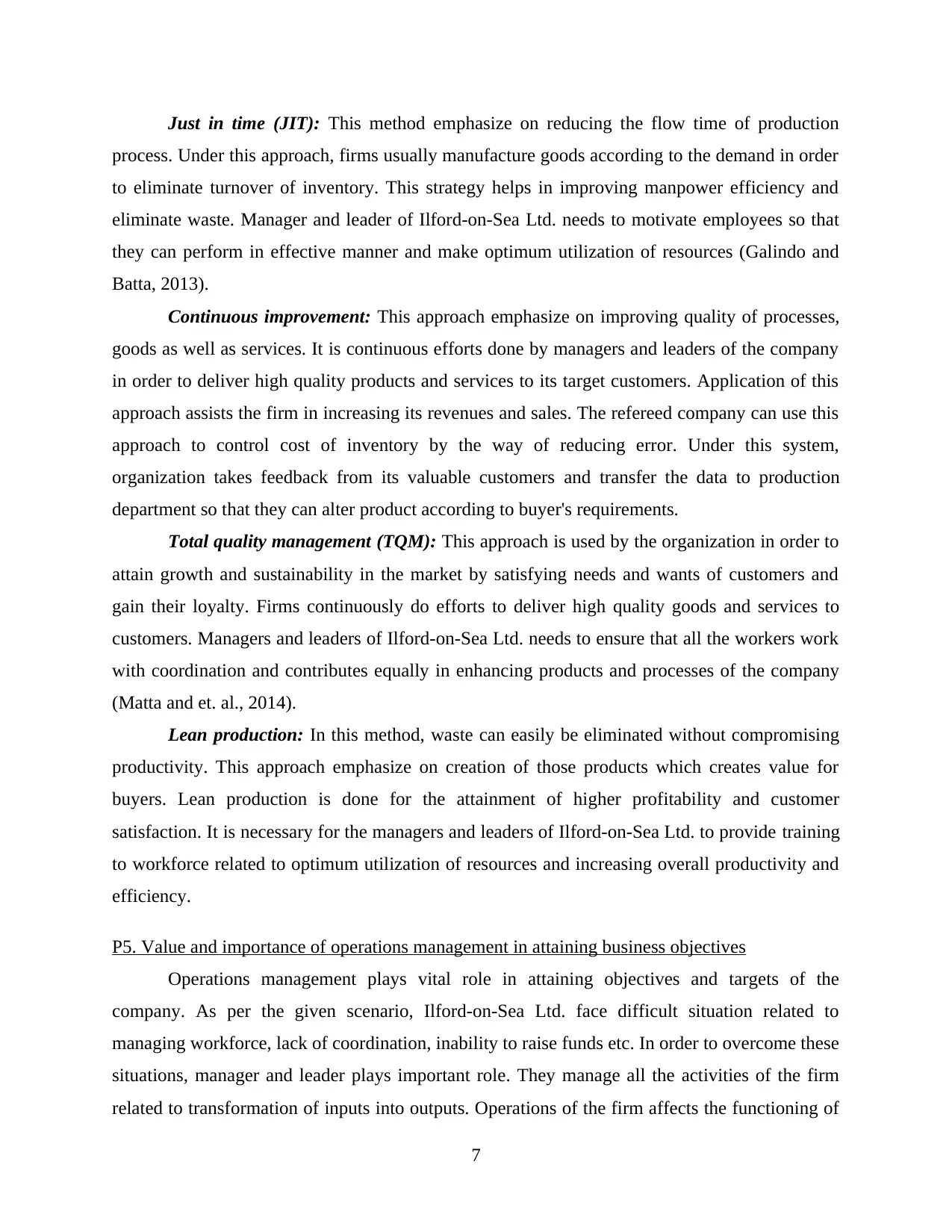
Just in time (JIT): This method emphasize on reducing the flow time of production
process. Under this approach, firms usually manufacture goods according to the demand in order
to eliminate turnover of inventory. This strategy helps in improving manpower efficiency and
eliminate waste. Manager and leader of Ilford-on-Sea Ltd. needs to motivate employees so that
they can perform in effective manner and make optimum utilization of resources (Galindo and
Batta, 2013).
Continuous improvement: This approach emphasize on improving quality of processes,
goods as well as services. It is continuous efforts done by managers and leaders of the company
in order to deliver high quality products and services to its target customers. Application of this
approach assists the firm in increasing its revenues and sales. The refereed company can use this
approach to control cost of inventory by the way of reducing error. Under this system,
organization takes feedback from its valuable customers and transfer the data to production
department so that they can alter product according to buyer's requirements.
Total quality management (TQM): This approach is used by the organization in order to
attain growth and sustainability in the market by satisfying needs and wants of customers and
gain their loyalty. Firms continuously do efforts to deliver high quality goods and services to
customers. Managers and leaders of Ilford-on-Sea Ltd. needs to ensure that all the workers work
with coordination and contributes equally in enhancing products and processes of the company
(Matta and et. al., 2014).
Lean production: In this method, waste can easily be eliminated without compromising
productivity. This approach emphasize on creation of those products which creates value for
buyers. Lean production is done for the attainment of higher profitability and customer
satisfaction. It is necessary for the managers and leaders of Ilford-on-Sea Ltd. to provide training
to workforce related to optimum utilization of resources and increasing overall productivity and
efficiency.
P5. Value and importance of operations management in attaining business objectives
Operations management plays vital role in attaining objectives and targets of the
company. As per the given scenario, Ilford-on-Sea Ltd. face difficult situation related to
managing workforce, lack of coordination, inability to raise funds etc. In order to overcome these
situations, manager and leader plays important role. They manage all the activities of the firm
related to transformation of inputs into outputs. Operations of the firm affects the functioning of
7
process. Under this approach, firms usually manufacture goods according to the demand in order
to eliminate turnover of inventory. This strategy helps in improving manpower efficiency and
eliminate waste. Manager and leader of Ilford-on-Sea Ltd. needs to motivate employees so that
they can perform in effective manner and make optimum utilization of resources (Galindo and
Batta, 2013).
Continuous improvement: This approach emphasize on improving quality of processes,
goods as well as services. It is continuous efforts done by managers and leaders of the company
in order to deliver high quality products and services to its target customers. Application of this
approach assists the firm in increasing its revenues and sales. The refereed company can use this
approach to control cost of inventory by the way of reducing error. Under this system,
organization takes feedback from its valuable customers and transfer the data to production
department so that they can alter product according to buyer's requirements.
Total quality management (TQM): This approach is used by the organization in order to
attain growth and sustainability in the market by satisfying needs and wants of customers and
gain their loyalty. Firms continuously do efforts to deliver high quality goods and services to
customers. Managers and leaders of Ilford-on-Sea Ltd. needs to ensure that all the workers work
with coordination and contributes equally in enhancing products and processes of the company
(Matta and et. al., 2014).
Lean production: In this method, waste can easily be eliminated without compromising
productivity. This approach emphasize on creation of those products which creates value for
buyers. Lean production is done for the attainment of higher profitability and customer
satisfaction. It is necessary for the managers and leaders of Ilford-on-Sea Ltd. to provide training
to workforce related to optimum utilization of resources and increasing overall productivity and
efficiency.
P5. Value and importance of operations management in attaining business objectives
Operations management plays vital role in attaining objectives and targets of the
company. As per the given scenario, Ilford-on-Sea Ltd. face difficult situation related to
managing workforce, lack of coordination, inability to raise funds etc. In order to overcome these
situations, manager and leader plays important role. They manage all the activities of the firm
related to transformation of inputs into outputs. Operations of the firm affects the functioning of
7
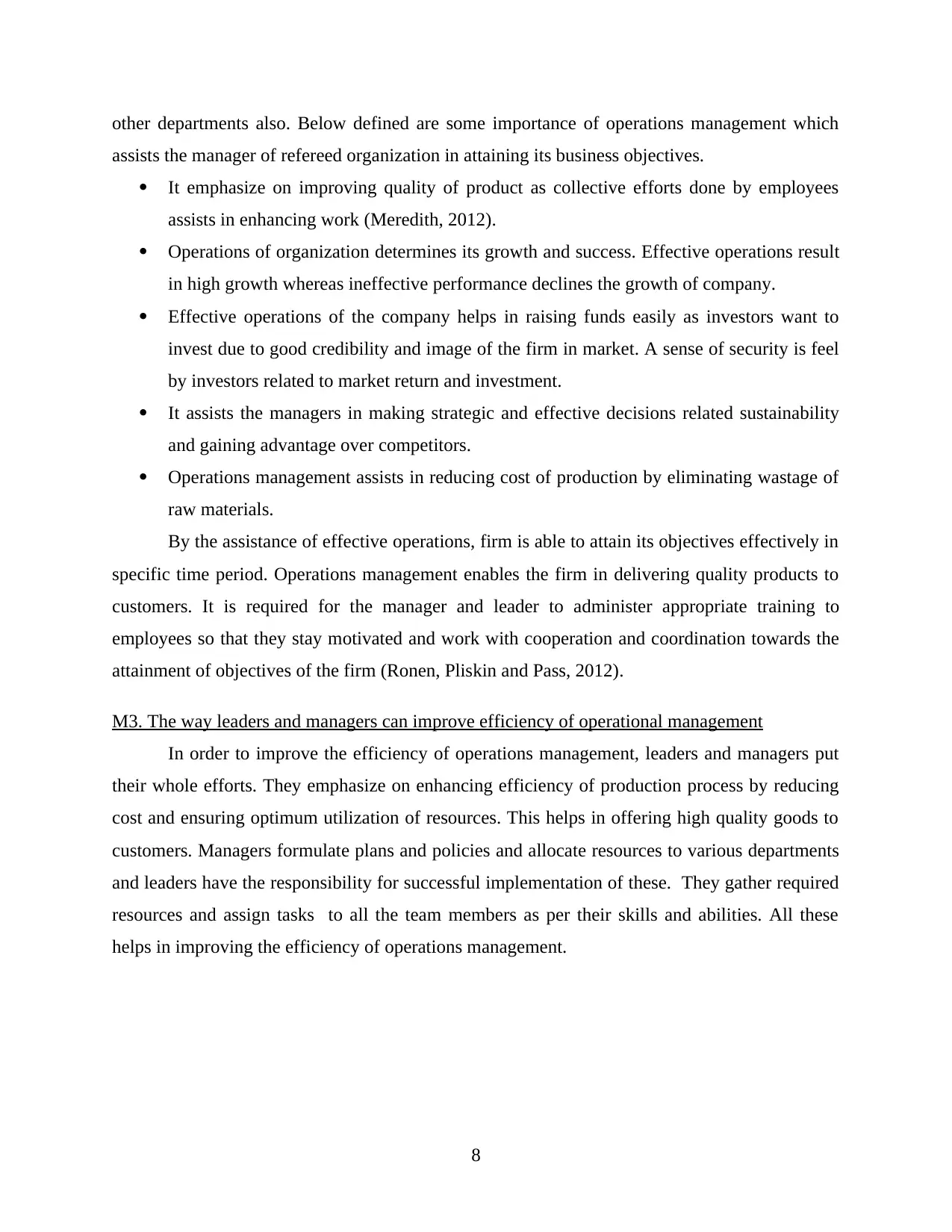
other departments also. Below defined are some importance of operations management which
assists the manager of refereed organization in attaining its business objectives.
It emphasize on improving quality of product as collective efforts done by employees
assists in enhancing work (Meredith, 2012).
Operations of organization determines its growth and success. Effective operations result
in high growth whereas ineffective performance declines the growth of company.
Effective operations of the company helps in raising funds easily as investors want to
invest due to good credibility and image of the firm in market. A sense of security is feel
by investors related to market return and investment.
It assists the managers in making strategic and effective decisions related sustainability
and gaining advantage over competitors.
Operations management assists in reducing cost of production by eliminating wastage of
raw materials.
By the assistance of effective operations, firm is able to attain its objectives effectively in
specific time period. Operations management enables the firm in delivering quality products to
customers. It is required for the manager and leader to administer appropriate training to
employees so that they stay motivated and work with cooperation and coordination towards the
attainment of objectives of the firm (Ronen, Pliskin and Pass, 2012).
M3. The way leaders and managers can improve efficiency of operational management
In order to improve the efficiency of operations management, leaders and managers put
their whole efforts. They emphasize on enhancing efficiency of production process by reducing
cost and ensuring optimum utilization of resources. This helps in offering high quality goods to
customers. Managers formulate plans and policies and allocate resources to various departments
and leaders have the responsibility for successful implementation of these. They gather required
resources and assign tasks to all the team members as per their skills and abilities. All these
helps in improving the efficiency of operations management.
8
assists the manager of refereed organization in attaining its business objectives.
It emphasize on improving quality of product as collective efforts done by employees
assists in enhancing work (Meredith, 2012).
Operations of organization determines its growth and success. Effective operations result
in high growth whereas ineffective performance declines the growth of company.
Effective operations of the company helps in raising funds easily as investors want to
invest due to good credibility and image of the firm in market. A sense of security is feel
by investors related to market return and investment.
It assists the managers in making strategic and effective decisions related sustainability
and gaining advantage over competitors.
Operations management assists in reducing cost of production by eliminating wastage of
raw materials.
By the assistance of effective operations, firm is able to attain its objectives effectively in
specific time period. Operations management enables the firm in delivering quality products to
customers. It is required for the manager and leader to administer appropriate training to
employees so that they stay motivated and work with cooperation and coordination towards the
attainment of objectives of the firm (Ronen, Pliskin and Pass, 2012).
M3. The way leaders and managers can improve efficiency of operational management
In order to improve the efficiency of operations management, leaders and managers put
their whole efforts. They emphasize on enhancing efficiency of production process by reducing
cost and ensuring optimum utilization of resources. This helps in offering high quality goods to
customers. Managers formulate plans and policies and allocate resources to various departments
and leaders have the responsibility for successful implementation of these. They gather required
resources and assign tasks to all the team members as per their skills and abilities. All these
helps in improving the efficiency of operations management.
8
⊘ This is a preview!⊘
Do you want full access?
Subscribe today to unlock all pages.

Trusted by 1+ million students worldwide
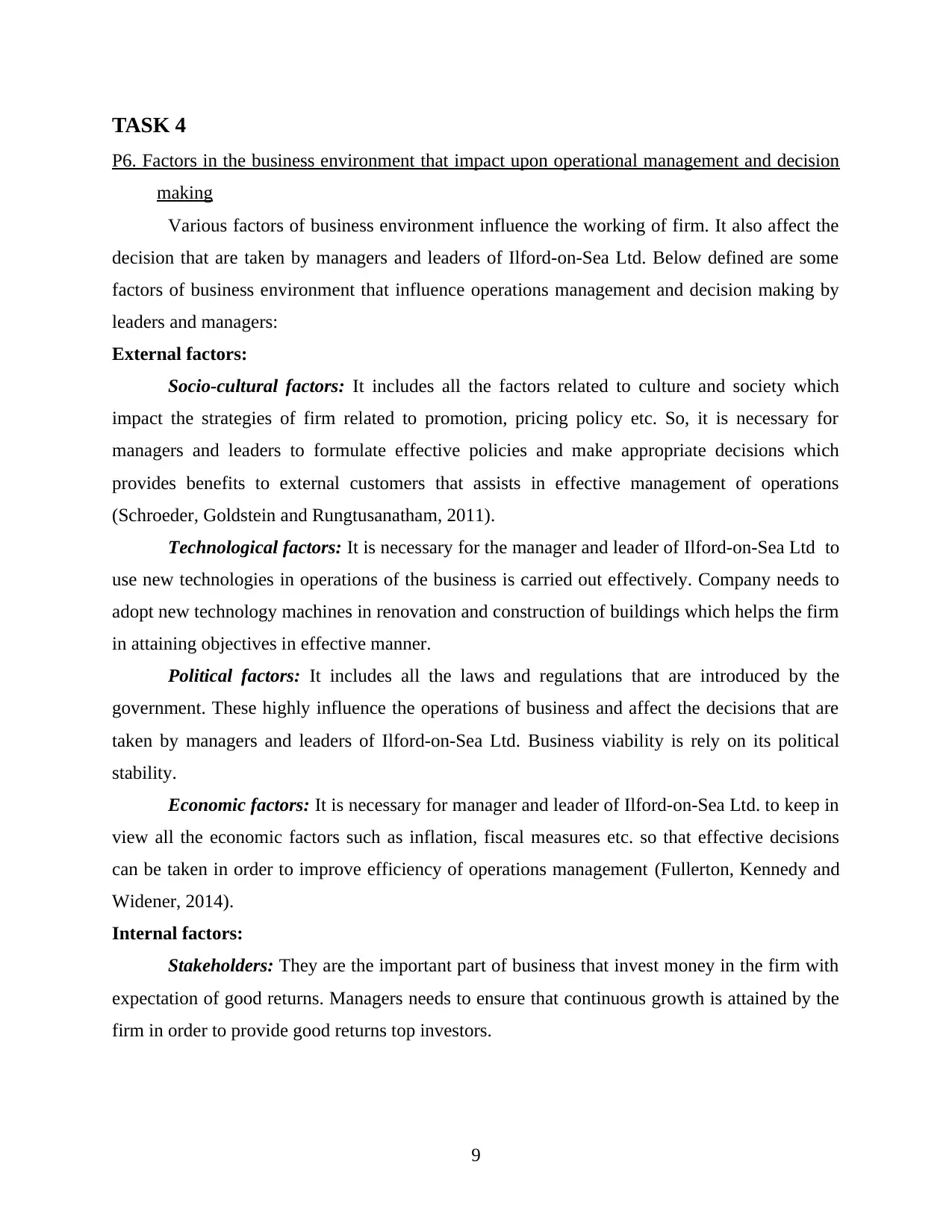
TASK 4
P6. Factors in the business environment that impact upon operational management and decision
making
Various factors of business environment influence the working of firm. It also affect the
decision that are taken by managers and leaders of Ilford-on-Sea Ltd. Below defined are some
factors of business environment that influence operations management and decision making by
leaders and managers:
External factors:
Socio-cultural factors: It includes all the factors related to culture and society which
impact the strategies of firm related to promotion, pricing policy etc. So, it is necessary for
managers and leaders to formulate effective policies and make appropriate decisions which
provides benefits to external customers that assists in effective management of operations
(Schroeder, Goldstein and Rungtusanatham, 2011).
Technological factors: It is necessary for the manager and leader of Ilford-on-Sea Ltd to
use new technologies in operations of the business is carried out effectively. Company needs to
adopt new technology machines in renovation and construction of buildings which helps the firm
in attaining objectives in effective manner.
Political factors: It includes all the laws and regulations that are introduced by the
government. These highly influence the operations of business and affect the decisions that are
taken by managers and leaders of Ilford-on-Sea Ltd. Business viability is rely on its political
stability.
Economic factors: It is necessary for manager and leader of Ilford-on-Sea Ltd. to keep in
view all the economic factors such as inflation, fiscal measures etc. so that effective decisions
can be taken in order to improve efficiency of operations management (Fullerton, Kennedy and
Widener, 2014).
Internal factors:
Stakeholders: They are the important part of business that invest money in the firm with
expectation of good returns. Managers needs to ensure that continuous growth is attained by the
firm in order to provide good returns top investors.
9
P6. Factors in the business environment that impact upon operational management and decision
making
Various factors of business environment influence the working of firm. It also affect the
decision that are taken by managers and leaders of Ilford-on-Sea Ltd. Below defined are some
factors of business environment that influence operations management and decision making by
leaders and managers:
External factors:
Socio-cultural factors: It includes all the factors related to culture and society which
impact the strategies of firm related to promotion, pricing policy etc. So, it is necessary for
managers and leaders to formulate effective policies and make appropriate decisions which
provides benefits to external customers that assists in effective management of operations
(Schroeder, Goldstein and Rungtusanatham, 2011).
Technological factors: It is necessary for the manager and leader of Ilford-on-Sea Ltd to
use new technologies in operations of the business is carried out effectively. Company needs to
adopt new technology machines in renovation and construction of buildings which helps the firm
in attaining objectives in effective manner.
Political factors: It includes all the laws and regulations that are introduced by the
government. These highly influence the operations of business and affect the decisions that are
taken by managers and leaders of Ilford-on-Sea Ltd. Business viability is rely on its political
stability.
Economic factors: It is necessary for manager and leader of Ilford-on-Sea Ltd. to keep in
view all the economic factors such as inflation, fiscal measures etc. so that effective decisions
can be taken in order to improve efficiency of operations management (Fullerton, Kennedy and
Widener, 2014).
Internal factors:
Stakeholders: They are the important part of business that invest money in the firm with
expectation of good returns. Managers needs to ensure that continuous growth is attained by the
firm in order to provide good returns top investors.
9
Paraphrase This Document
Need a fresh take? Get an instant paraphrase of this document with our AI Paraphraser
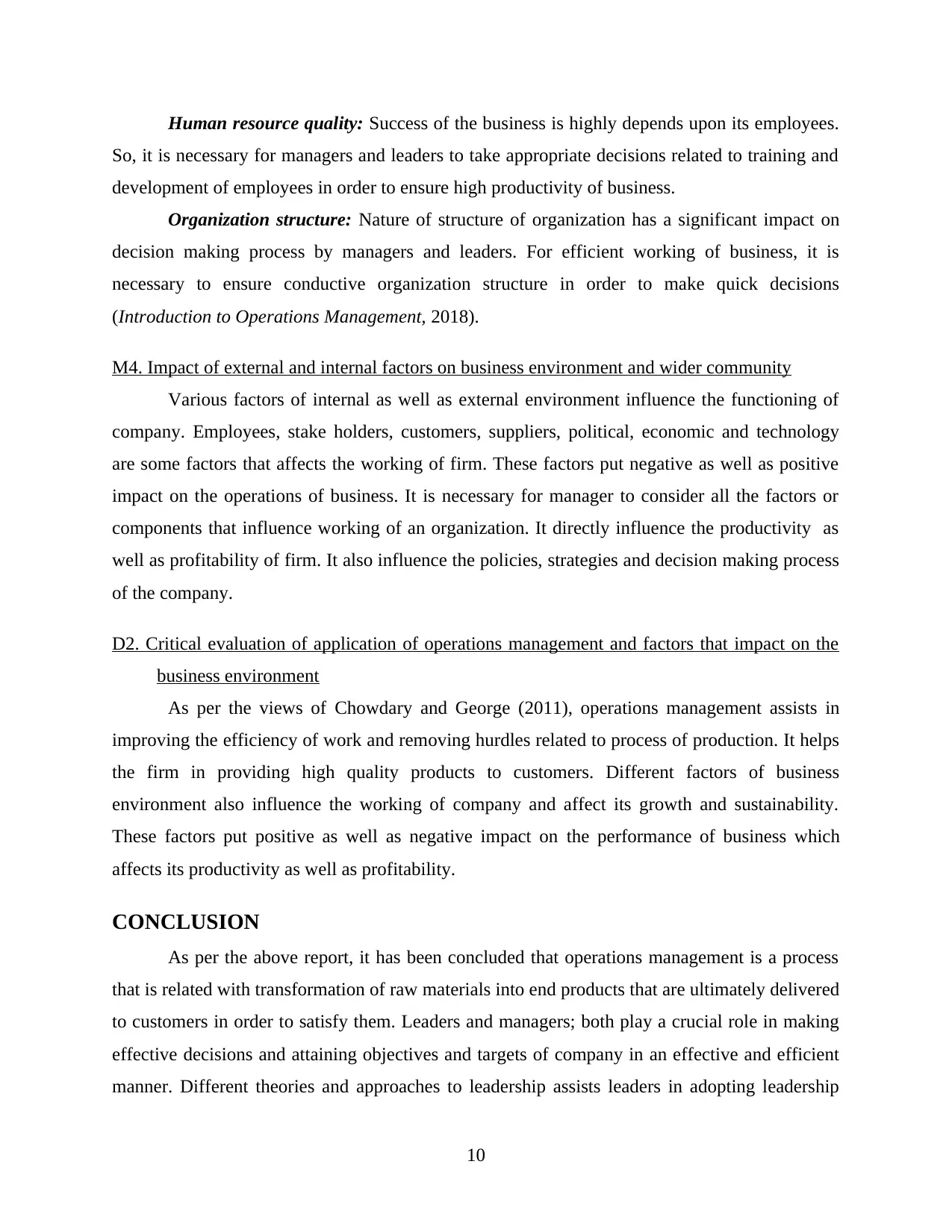
Human resource quality: Success of the business is highly depends upon its employees.
So, it is necessary for managers and leaders to take appropriate decisions related to training and
development of employees in order to ensure high productivity of business.
Organization structure: Nature of structure of organization has a significant impact on
decision making process by managers and leaders. For efficient working of business, it is
necessary to ensure conductive organization structure in order to make quick decisions
(Introduction to Operations Management, 2018).
M4. Impact of external and internal factors on business environment and wider community
Various factors of internal as well as external environment influence the functioning of
company. Employees, stake holders, customers, suppliers, political, economic and technology
are some factors that affects the working of firm. These factors put negative as well as positive
impact on the operations of business. It is necessary for manager to consider all the factors or
components that influence working of an organization. It directly influence the productivity as
well as profitability of firm. It also influence the policies, strategies and decision making process
of the company.
D2. Critical evaluation of application of operations management and factors that impact on the
business environment
As per the views of Chowdary and George (2011), operations management assists in
improving the efficiency of work and removing hurdles related to process of production. It helps
the firm in providing high quality products to customers. Different factors of business
environment also influence the working of company and affect its growth and sustainability.
These factors put positive as well as negative impact on the performance of business which
affects its productivity as well as profitability.
CONCLUSION
As per the above report, it has been concluded that operations management is a process
that is related with transformation of raw materials into end products that are ultimately delivered
to customers in order to satisfy them. Leaders and managers; both play a crucial role in making
effective decisions and attaining objectives and targets of company in an effective and efficient
manner. Different theories and approaches to leadership assists leaders in adopting leadership
10
So, it is necessary for managers and leaders to take appropriate decisions related to training and
development of employees in order to ensure high productivity of business.
Organization structure: Nature of structure of organization has a significant impact on
decision making process by managers and leaders. For efficient working of business, it is
necessary to ensure conductive organization structure in order to make quick decisions
(Introduction to Operations Management, 2018).
M4. Impact of external and internal factors on business environment and wider community
Various factors of internal as well as external environment influence the functioning of
company. Employees, stake holders, customers, suppliers, political, economic and technology
are some factors that affects the working of firm. These factors put negative as well as positive
impact on the operations of business. It is necessary for manager to consider all the factors or
components that influence working of an organization. It directly influence the productivity as
well as profitability of firm. It also influence the policies, strategies and decision making process
of the company.
D2. Critical evaluation of application of operations management and factors that impact on the
business environment
As per the views of Chowdary and George (2011), operations management assists in
improving the efficiency of work and removing hurdles related to process of production. It helps
the firm in providing high quality products to customers. Different factors of business
environment also influence the working of company and affect its growth and sustainability.
These factors put positive as well as negative impact on the performance of business which
affects its productivity as well as profitability.
CONCLUSION
As per the above report, it has been concluded that operations management is a process
that is related with transformation of raw materials into end products that are ultimately delivered
to customers in order to satisfy them. Leaders and managers; both play a crucial role in making
effective decisions and attaining objectives and targets of company in an effective and efficient
manner. Different theories and approaches to leadership assists leaders in adopting leadership
10
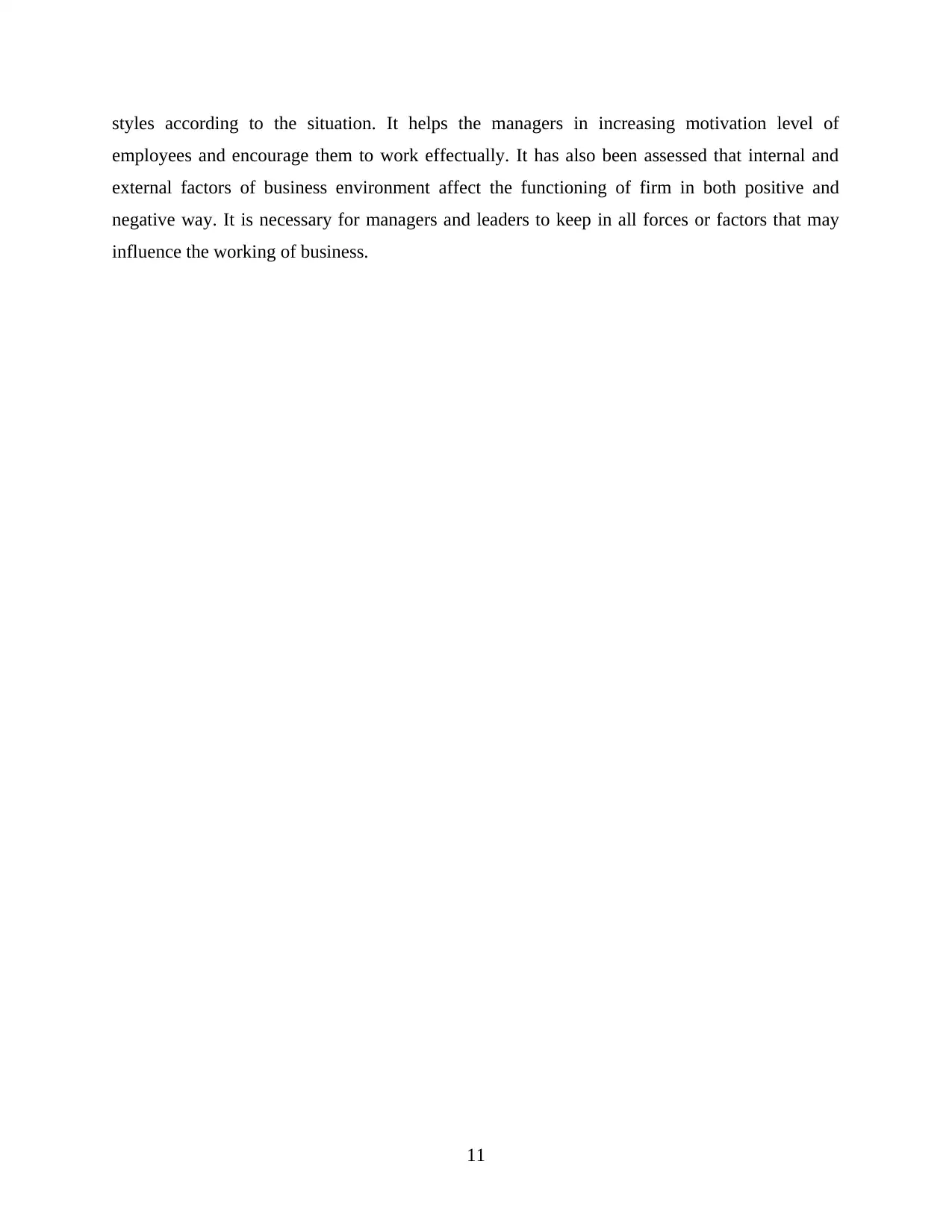
styles according to the situation. It helps the managers in increasing motivation level of
employees and encourage them to work effectually. It has also been assessed that internal and
external factors of business environment affect the functioning of firm in both positive and
negative way. It is necessary for managers and leaders to keep in all forces or factors that may
influence the working of business.
11
employees and encourage them to work effectually. It has also been assessed that internal and
external factors of business environment affect the functioning of firm in both positive and
negative way. It is necessary for managers and leaders to keep in all forces or factors that may
influence the working of business.
11
⊘ This is a preview!⊘
Do you want full access?
Subscribe today to unlock all pages.

Trusted by 1+ million students worldwide
1 out of 13
Related Documents
Your All-in-One AI-Powered Toolkit for Academic Success.
+13062052269
info@desklib.com
Available 24*7 on WhatsApp / Email
![[object Object]](/_next/static/media/star-bottom.7253800d.svg)
Unlock your academic potential
Copyright © 2020–2025 A2Z Services. All Rights Reserved. Developed and managed by ZUCOL.





